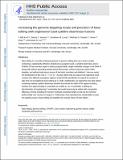| dc.contributor.author | Kim, Y. Bill | en_US |
| dc.contributor.author | Komor, Alexis C. | en_US |
| dc.contributor.author | Levy, Jonathan M. | en_US |
| dc.contributor.author | Packer, Michael S. | en_US |
| dc.contributor.author | Zhao, Kevin T. | en_US |
| dc.contributor.author | Liu, David R. | en_US |
| dc.date.accessioned | 2017-11-21T20:45:47Z | |
| dc.date.issued | 2017 | en_US |
| dc.identifier.citation | Kim, Y. Bill, Alexis C. Komor, Jonathan M. Levy, Michael S. Packer, Kevin T. Zhao, and David R. Liu. 2017. “Increasing the genome-targeting scope and precision of base editing with engineered Cas9-cytidine deaminase fusions.” Nature biotechnology 35 (4): 371-376. doi:10.1038/nbt.3803. http://dx.doi.org/10.1038/nbt.3803. | en |
| dc.identifier.issn | | en |
| dc.identifier.uri | http://nrs.harvard.edu/urn-3:HUL.InstRepos:34375291 | |
| dc.description.abstract | Base editing is a recently developed approach to genome editing that uses a fusion protein containing a catalytically defective Streptococcus pyogenes Cas9, a cytidine deaminase, and an inhibitor of base excision repair to induce programmable, single-nucleotide changes in the DNA of living cells without generating double-strand DNA breaks, without requiring a donor DNA template, and without inducing an excess of stochastic insertions and deletions1. Here we report the development of five new C→T (or G→A) base editors that use natural and engineered Cas9 variants with different protospacer-adjacent motif (PAM) specificities to expand the number of sites that can be targeted by base editing by 2.5-fold. Additionally, we engineered new base editors containing mutated cytidine deaminase domains that narrow the width of the apparent editing window from approximately 5 nucleotides to as little as 1 to 2 nucleotides, enabling the discrimination of neighboring C nucleotides that would previously be edited with comparable efficiency, thereby doubling the number of disease-associated target Cs that can be corrected preferentially over nearby non-target Cs. Collectively, these developments substantially increase the targeting scope of base editing and establish the modular nature of base editors. | en |
| dc.language.iso | en_US | en |
| dc.relation.isversionof | doi:10.1038/nbt.3803 | en |
| dc.relation.hasversion | http://www.ncbi.nlm.nih.gov/pmc/articles/PMC5388574/pdf/ | en |
| dash.license | LAA | en_US |
| dc.subject | Base editing | en |
| dc.subject | genome editing | en |
| dc.subject | CRISPR | en |
| dc.subject | Cas9 | en |
| dc.subject | protein engineering | en |
| dc.subject | genetic disease | en |
| dc.subject | single-nucleotide polymorphism | en |
| dc.title | Increasing the genome-targeting scope and precision of base editing with engineered Cas9-cytidine deaminase fusions | en |
| dc.type | Journal Article | en_US |
| dc.description.version | Version of Record | en |
| dc.relation.journal | Nature biotechnology | en |
| dash.depositing.author | Levy, Jonathan M. | en_US |
| dc.date.available | 2017-11-21T20:45:47Z | |
| dc.identifier.doi | 10.1038/nbt.3803 | * |
| dash.contributor.affiliated | Zhao, Kevin | |
| dash.contributor.affiliated | Levy, Jonathan | |
| dash.contributor.affiliated | Liu, David | |


